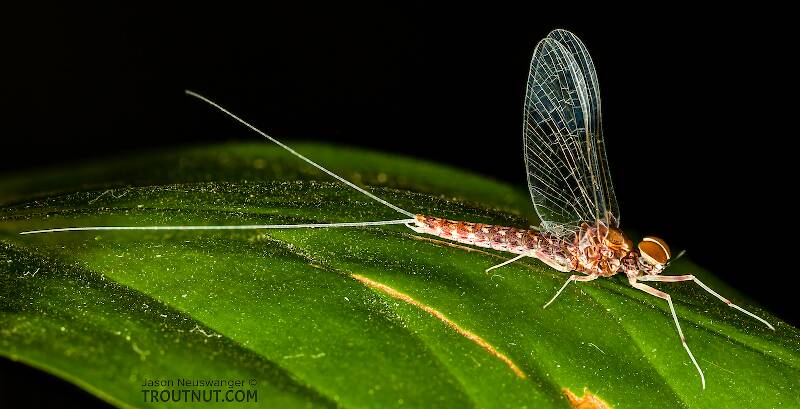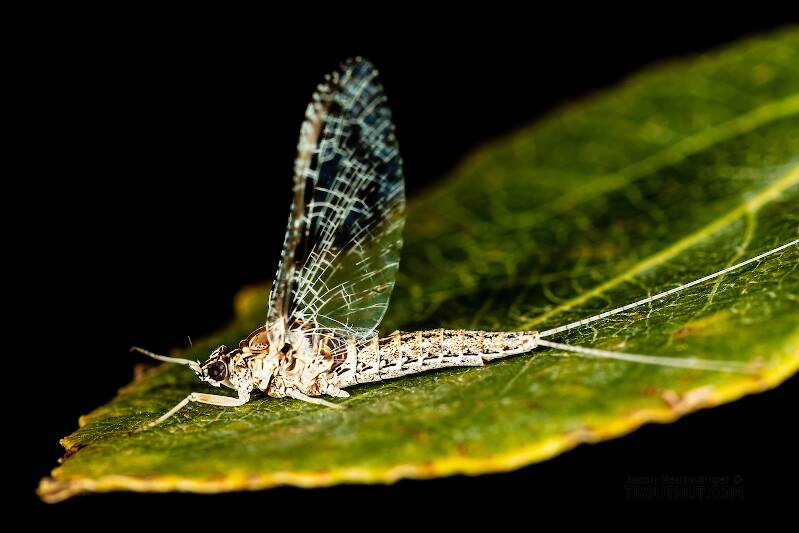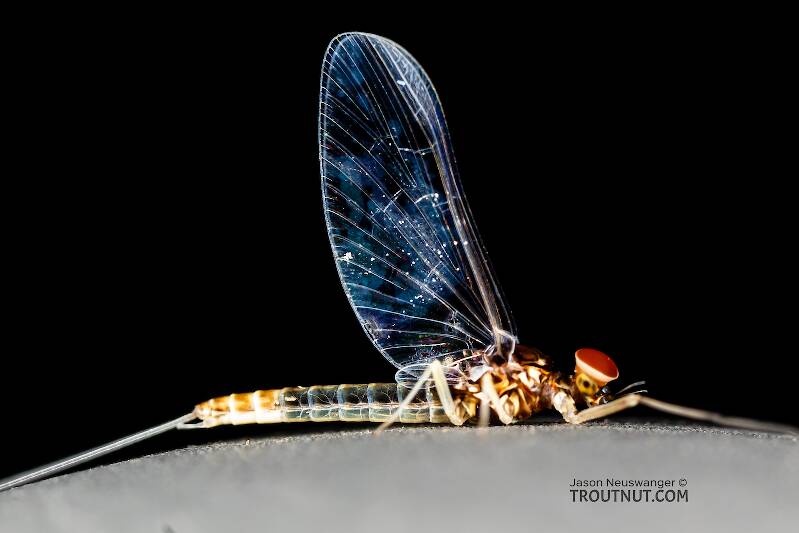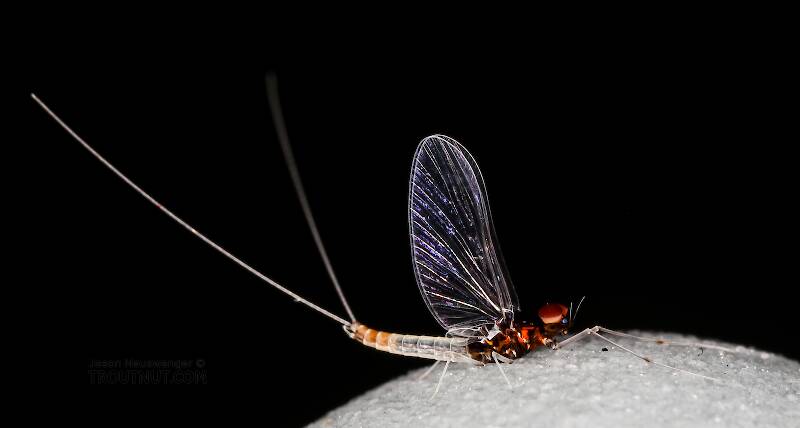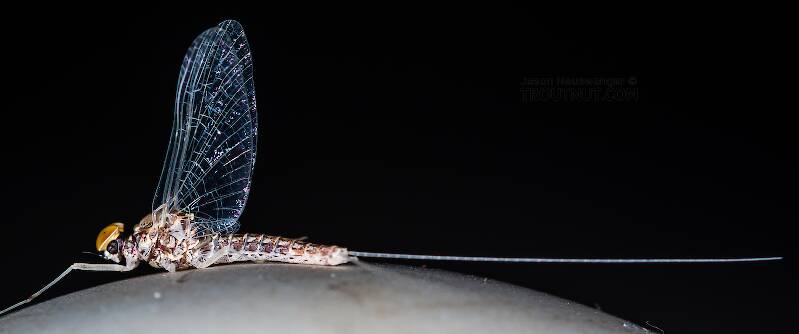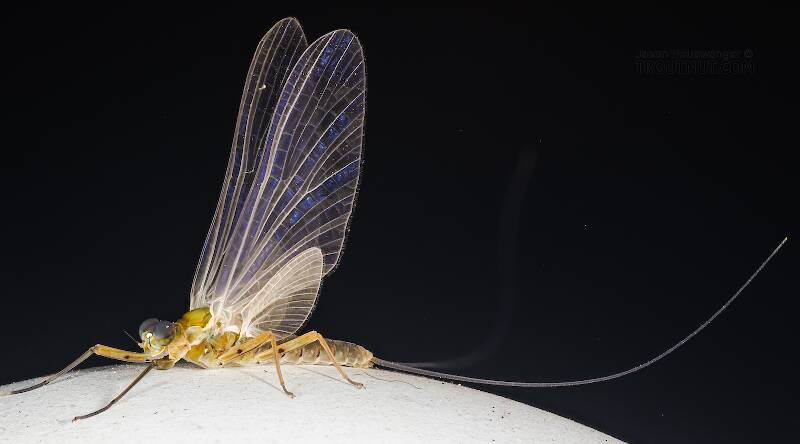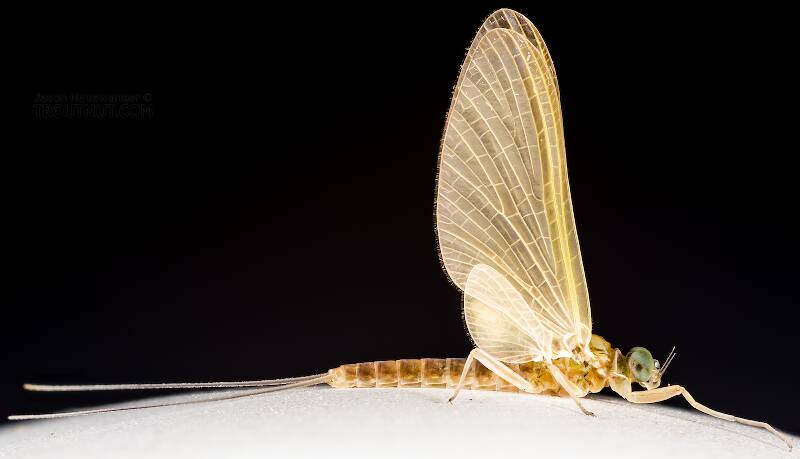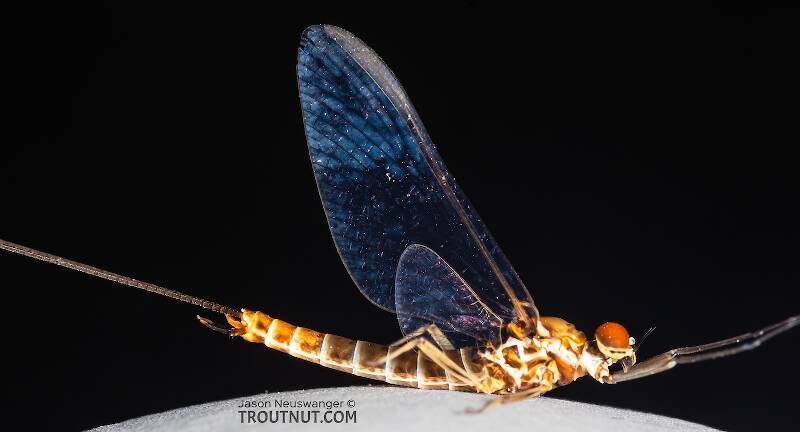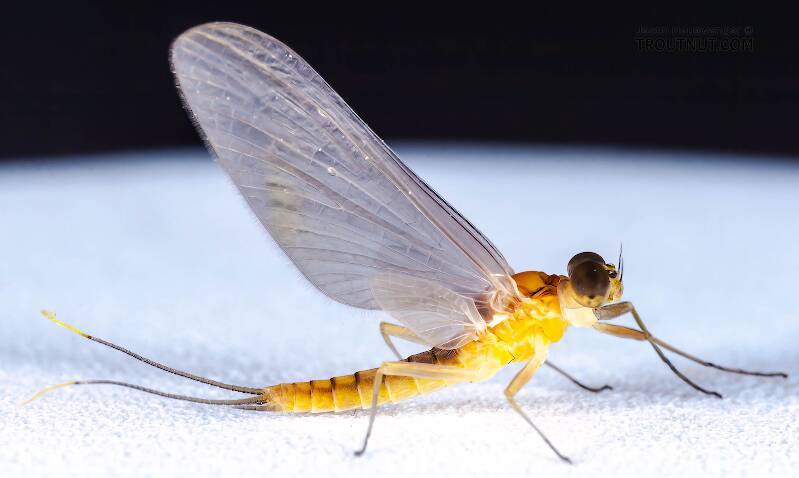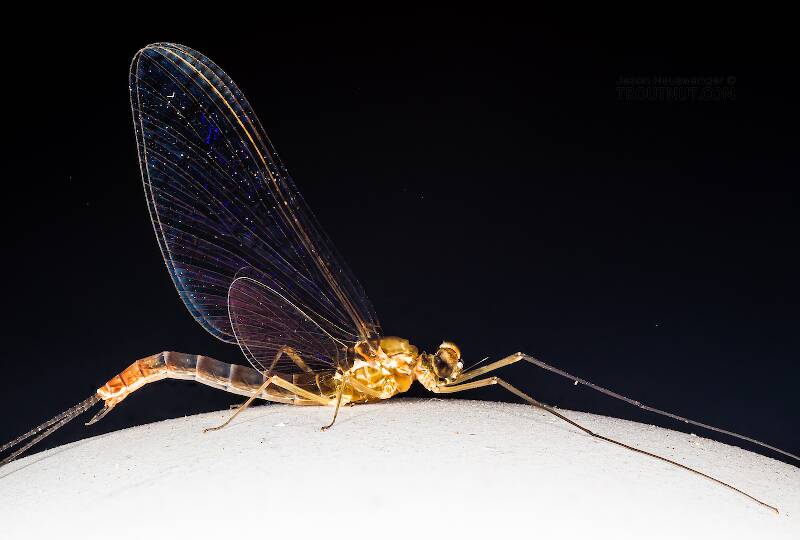
Salmonflies
Pteronarcys californica
The giant Salmonflies of the Western mountains are legendary for their proclivity to elicit consistent dry-fly action and ferocious strikes.
Featured on the forum

This dun emerged from a mature nymph on my desk. Unfortunately its wings didn't perfectly dry out.

Troutnut is a project started in 2003 by salmonid ecologist Jason "Troutnut" Neuswanger to help anglers and
fly tyers unabashedly embrace the entomological side of the sport. Learn more about Troutnut or
support the project for an enhanced experience here.
Identification: Key to Families of Mayfly Duns and Spinners, Couplet 15
Identification: Key to Families of Mayfly Duns and Spinners, Couplet 15
Error: Tried to access a key that isn't live.
Adapted from Merritt R.W., Cummins, K.W., and Berg, M.B. (2019)
This couplet refers figures (usually designated 'sf') from this source.
You will need the source (make sure to get the same edition!) to see them.
This couplet refers figures (usually designated 'sf') from this source.
You will need the source (make sure to get the same edition!) to see them.
| Option 1 | Option 2 |
|---|---|
Short, basally detached, single or double marginal intercalary veins present in each interspace of forewings 
| Marginal intercalary veins attached basally to other veins |
Hind wings small or absent 
| Hind wings relatively large 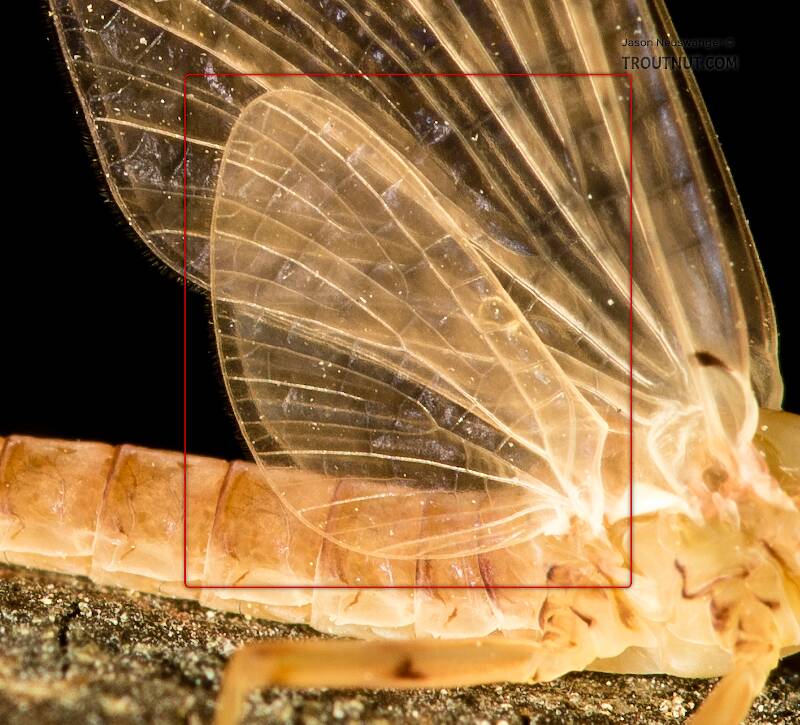
|
Compound eyes of male turbinate 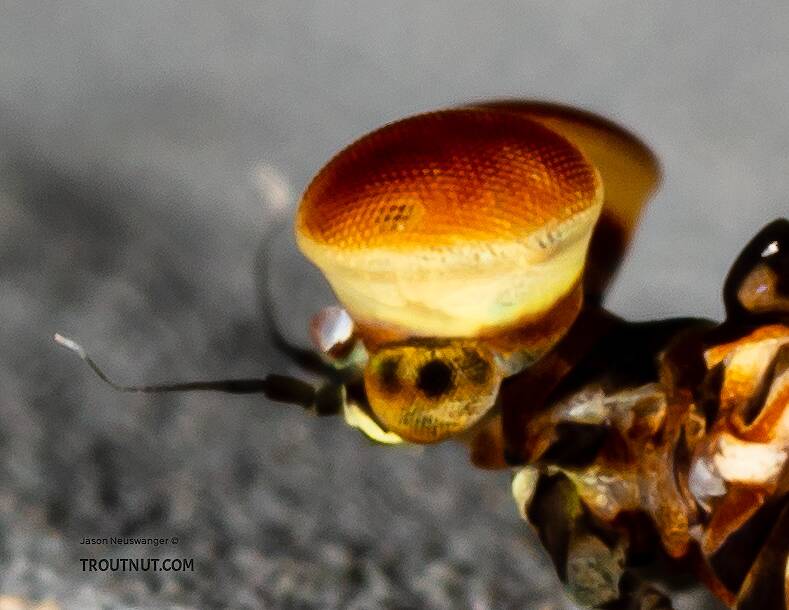
| Compound eyes of male not turbinate 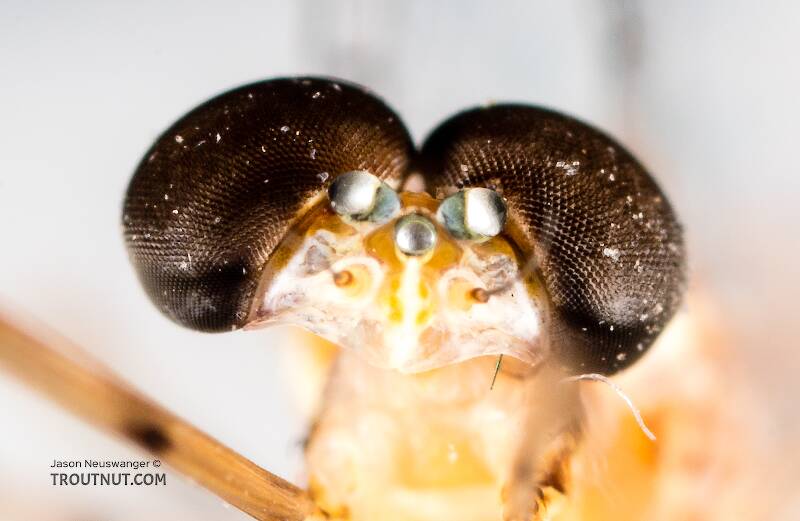
|
| Forewing veins MA2 and MP2 detached basally from their respective stem veins (source fig 13.185) | Forewing veins veins MA2 and MP2 attached basally (source figs 13.187, 13.188) |
| Penes of male membranous | Penes of male well-developed |
| Remaining families: Arthropleidae, Heptageniidae, Metretopodidae, and Pseudironidae | |
5 Example Specimens | 5 Example Specimens |
| Baetidae | Go to Couplet 16 |
Adapted from Merritt R.W., Cummins, K.W., and Berg, M.B. (2019)
The current couplet is highlighted with darker colors and a icon, and couplets leading to this point have a icon.
Leads to Oligoneuriidae:
- Forewing venation abnormally sparse, with only 3-4 longitudinal veins behind vein R1
- Body dark
- Not common in trout streams
Oligoneuriidae
Leads to Couplet 2:
- Forewing venation normal or only moderately reduced, with numerous longitudinal veins present behind vein R1
- Body color variable
- Very common in trout streams
Couplet 2
Leads to Behningiidae
(Dolania americana):
(Dolania americana):
- Penes of male longer than forceps (source fig 13.170)
- Antennae of female inserted on prominent anterolateral projections (source fig 13.171)
- First intercalary vein beyond vein CuA of forewings subparallel to and almost as long as CuA
- First intercalary vein attached to CuA by 7 or more unbranched crossveins (source fig 13.164)
Behningiidae
(Dolania americana)
(Dolania americana)
Leads to Couplet 3:
- Penes of male shorter than forceps (source fig 13.172)
- Antennae of female not inserted on prominent anterolateral projections
- First intercalary vein behind CuA of forewings much shorter than CuA
- Few or no crossveins attaching first intercalary vein to CuA (many source figs) or crossveins anastomosed, especially near wing margin
Couplet 3
Leads to Couplet 4:
- Base of veins MP2 and CuA in forewings strongly divergent from base of vein MP1
- Base of vein MP2 strongly bent toward CuA (source figs 13.165.13.168) and sometimes fused at base with CuA
- Fork of vein MP usually less symmetrical
- Hind wings with numerous veins and crossveins
- Vein MA of hind wings unforked (source figs 13.165-13.168)
Couplet 4
Leads to Couplet 8:
- Base of veins MP2 and CuA in forewings not strongly divergent from base of vein MP1
- Base of vein MP2 may only diverge from MP1
- Fork of vein MP usually more symmetrical (many source figs)
- Hind wings may have numerous veins and crossveins, but are sometimes reduced or absent
- If hind wings present, vein MA variable
Couplet 8
Leads to Neoephemeridae
(Neoephemera):
(Neoephemera):
- Costal angle of hind wings acute or at a right angle (source fig 13.165b)
- Vein A1 of forewings unforked
- Costal crossveins of forewings basal of bullae weak or atrophied (source fig 13.165a)
Leads to Couplet 5:
- Costal angle of hind wings usually rounded (source figs 13.166-13.168)
- If costal angle of hind wings nearly acute or at right angles, then vein A1 of forewings forked near margin (source fig 13.167)
- Costal crossveins of forewing basal of bullae well-developed (source fig 13.167)
Couplet 5
Leads to Polymitarcyidae:
- Middle and hind legs of male and all legs of female feeble and nonfunctional
- Body color usually pale
Leads to Couplet 6:
- All legs of both sexes well-developed and functional
- Color variable
Couplet 6
Leads to Euthyplociidae
(Euthyplocia hecuba):
(Euthyplocia hecuba):
- Vein MA2 of forewings range from shorter than to slightly longer than base of vein MA (source fig 13.153)
- Male forceps either with two long basal segments and one or two short terminal segments (source fig 13.161)
- Mostly a tropical species; the only North American records are from Mexico
Euthyplociidae
(Euthyplocia hecuba)
(Euthyplocia hecuba)
Leads to Couplet 7:
- Vein MA2 of forewings range from shorter than to slightly longer than base of vein MA
- Male forceps either with two long basal segments and one or two short terminal segments or one long basal segment and two short terminal segments
- Widespread
Couplet 7
Leads to Potamanthidae
(Anthopotamus):
(Anthopotamus):
- Vein A1 of forewings forked near margin (source fig 13.167)
- Abdomen usually yellowish with reddish or pinkish lateral stripes or spots on tergites
Leads to Couplet 23:
- Vein A1 of forewings not forked near margin, attached to hind margin by three or more small veins (source fig 13.168)
- Abdomen of most species with distinctive dark contrasting patterns on tergites and sternites
Couplet 23
Leads to Couplet 9:
- Cubital intercalary veins of forewings consist of a series of small veins, often forking or sinuate that attach vein CuA to hind margin of wing (source figs 13.169, 13.175)
Couplet 9
Leads to Couplet 10:
- Cubital intercalary veins of forewings variable, but not as at left (many source figs); sometimes absent (source fig 13.184)
Couplet 10
Leads to Isonychiidae
(Isonychia):
(Isonychia):
- Remnants of gill tufts (often purplish colored) present at sides of vestigial maxillae and bases of forecoxae
- Forelegs mostly or completely dark, but middle and hind legs pale
- Vein MP of hind wings forked near margin (source figs 13.175)
- Terminal filament vestigial (colloquially, the mayfly has two tails)
Leads to Couplet 19:
- Remnants of gill tufts not present on vestigial maxillae or forecoxae
- Legs not colored as at left
- Vein MP of hind wings forked near base or near middle, but not near rear wing margin (source figs 13.169, 13.177)
- Terminal filament variable (colloquially, the mayfly has two or three tails)
Couplet 19
Leads to Couplet 11:
- Three well-developed tails (caudal filaments)
Couplet 11
Leads to Couplet 14:
- Two tails; third (terminal filament) rudimentary or absent
Couplet 14
Leads to Couplet 12:
- Hind wings relatively large with one or more veins forked
- Costal projection shorter than wing width (source figs 13.176, 13.181, 13.183)
- Size variable, often large
Couplet 12
Leads to Couplet 18:
- Hind wings small with only two or three simple veins, or hind wings absent (source figs 13.189, 13.190)
- If hind wings present, then costal projection long (1.5 to 3.0 times length of wing) and costal projection straight or recurved (source fig 13.188)
- Often among the smallest mayflies
Couplet 18
Leads to Ametropodidae
(Ametropus):
(Ametropus):
- Vein A1 of forewings attached to hind margin by series of small veins (source fig 13.176)
- Forewings with two pairs of cubital intercalary veins, with the anterior pair long and posterior pair very short
Leads to Couplet 13:
- Vein A1 of forewings not attached to hind margin as at left (source fig 13.181, 13.183)
- Cubital intercalary veins not as at left
Couplet 13
Leads to Ephemerellidae:
- Short, basally detached marginal intercalary veins present between primary wing veins along entire outer margins of fore- and hind wings
- Male forceps with one short terminal segment
Leads to Leptophlebiidae:
- Such intercalary veins absent, but occasionally with a small unattached marginal vein occurring irregularly along wing margins; most marginal intercalary veins attached to other veins
- Male forceps with two or three short terminal segments
Leads to Baetiscidae
(Baetisca):
(Baetisca):
- Hind wings with numerous, long, free marginal intercalary veins (source fig 13.184)
- Cubital intercalary veins absent in forewings with vein A1 terminating in outer margin of wings (source fig 13.184)
- Very distinctive, thick-bodied general appearance compared to other mayflies
Leads to Couplet 15:
- Hind wings not as at left, or absent
- If hind wings present, then cubital intercalary veins present in forewings with vein A1 terminating in hind margin of wings (source figs 13.185-13.187)
Couplet 15
Couplet 15 (You are here)
Leads to Baetidae:
- Short, basally detached, single or double marginal intercalary veins present in each interspace of forewings
- Hind wings small or absent
- Compound eyes of male turbinate
- Forewing veins MA2 and MP2 detached basally from their respective stem veins (source fig 13.185)
- Penes of male membranous
Leads to Couplet 16:
- Marginal intercalary veins attached basally to other veins
- Hind wings relatively large
- Compound eyes of male not turbinate
- Forewing veins veins MA2 and MP2 attached basally (source figs 13.187, 13.188)
- Penes of male well-developed
Couplet 16
Leads to Couplet 17:
- Hind tarsi appear four-segmented because the basal segment is fully or partially fused to tibiae
- Hind tarsi longer than hind tibiae
- One or two dissimilar pairs of cubital intercalary veins present (source figs 13.186, 13.187)
Couplet 17
Leads to Couplet 21:
- Hind tarsi distinctly five-segmented (source fig 13.194)
- Hind tarsi shorter than hind tibiae
- Two pairs of cubital intercalary veins present similar to those in source fig 13.186
Couplet 21
Leads to Metretopodidae:
- Compound eyes of male touching or nearly touching dorsally (similar to source fig 13.219)
- Foretarsi three times the length of foretibiae
- Abdomen of female not noticeably long and slender, and posterior margin of sternite 9 evenly convex without a median notch
Leads to Pseudironidae
(Pseudiron centralis):
(Pseudiron centralis):
- Compound eyes of male separated dorsally by twice the width of median ocellus
- Foretarsi twice the length of foretibiae
- Abdomen of female distinctly long and slender, and posterior margin of sternite 9 with median notch (source fig 13.191)
- Rare species found in sand-dominated rivers
Leads to Leptohyphidae:
- Vein MA of forewings forming a fairly symmetrical fork
- Veins MP2 and IMP extend less than 3/4 the distance to the base of vein MP (source figs 13.188, 13.189)
- Male forceps two or three-segmented
- Thorax usually black or gray
Leads to Acanthametropodidae:
- Three tails, with terminal filament distinctly longer than tergite 10
- Hind wings at least half as long as forewings
Acanthametropodidae
Leads to Couplet 20:
- Two tails (terminal filament vestigial)
- Hind wings less than half as long as forewings
Couplet 20
Leads to Ameletidae:
- Tarsal claws dissimilar, with one sharp and one blunt claw in each pair (source fig 13.208)
- Costal projections of hind wings acute (source fig 13.196)
Leads to Siphlonuridae:
- Tarsal claws similar, with two sharp claws in each pair (source fig 13.209)
- Costal projections of hind wins obtuse or weakly developed (source fig 13.169b)
Leads to Heptageniidae
(Cinygma):
(Cinygma):
- Stigmatic area of forewings divided by a thin, approximately straight vein into two series of small cells (source fig 13.215)
Leads to Couplet 22:
- Stigmatic area with either simple crossveins or anastomosed crossveins divided by a more irregular vein into two series of small cells, but not as at left (source fig 13.216)
Couplet 22
Leads to Arthropleidae
(Arthroplea bipunctata):
(Arthroplea bipunctata):
- Vein MA of hind wings simple, unforked
- Uncommon
Leads to Heptageniidae:
- Vein MA of hind wings forked (source fig 13.220)
- Very common
Leads to Ephemeridae:
- Pronotum large, but not more than twice as wide as long (source fig 13.173)
- Male penes variable, but not long and tubular
- Tails of female longer than body
Leads to Palingeniidae
(Pentagenia):
(Pentagenia):
- Pronotum short, about three times as wide as long (source fig 13.174)
- Penes of male long and tubular (source fig 13.173)
- Tails of female shorter than body
- Found in large rivers
Start a Discussion of this Couplet
References
- Merritt R.W., Cummins, K.W., and Berg, M.B. 2019. An Introduction to the Aquatic Insects of North America (Fifth Edition). Kendall/Hunt Publishing Company.
Description of this key
This is a comprehensive, scientifically rigorous key to the families of all North American mayfly adults, including some that are rarely found on trout streams. Anglers newer to entomology, looking to identify common mayflies, might prefer to use the Easy Angler's Key to Common Adult Mayflies.


